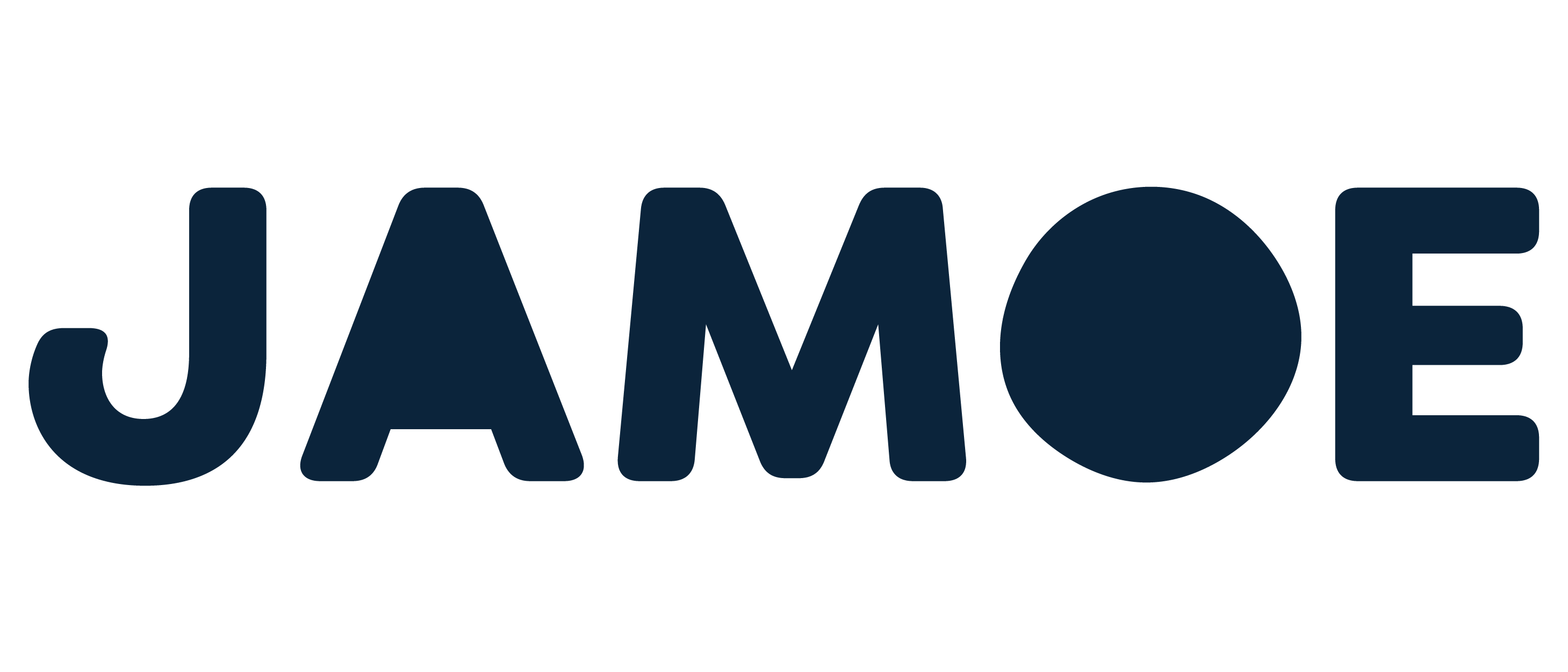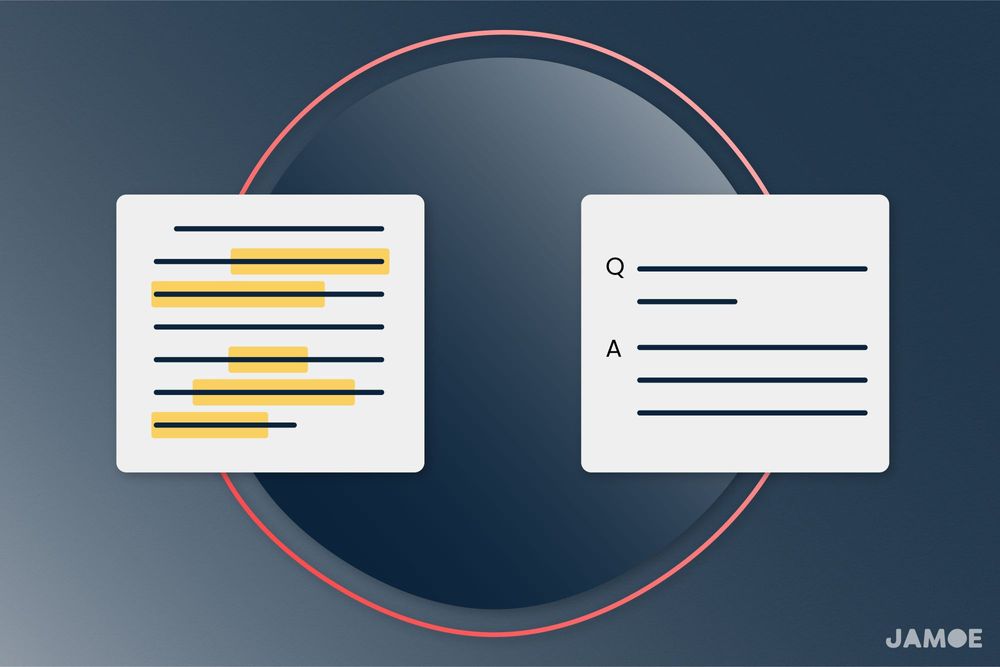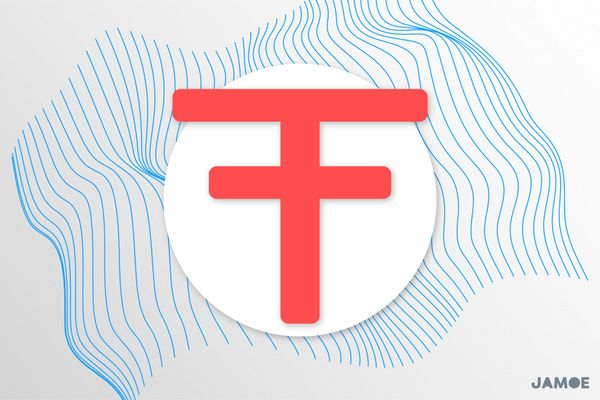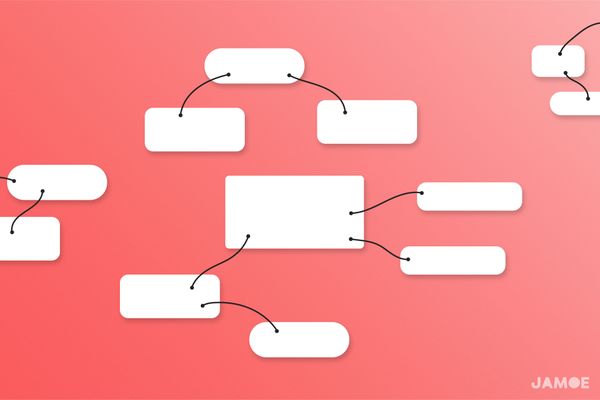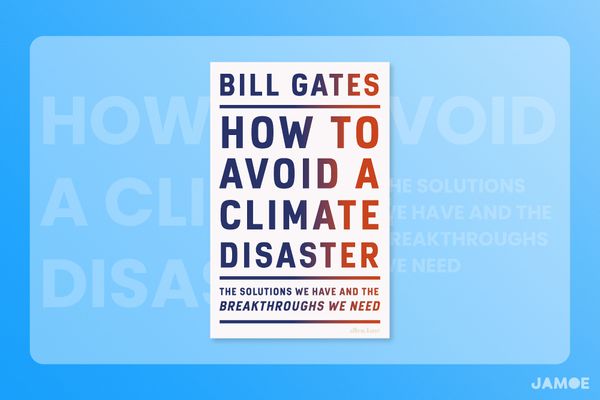Thinking Slow With HQ&A: Take Better Notes When Reading Non-Fiction (Pt 1)
This is part one in our note-taking series.
At a glance
- In a nutshell: As you stumble across valuable information, save it (Highlight) along with a question for which you see the passage as the answer (Question). Then write a compressed version of that passage expressed in your own words (Answer).
- Highlight, Question, and Answer (HQ&A) Notes are the knife in our knife and fork note-taking toolkit. While Jump Notes excel at shallow breadth for when we're thinking fast, HQ&A Notes are designed for narrow depth for when we're thinking slow. Together, they'll help you carve up what you're reading and push your thinking further.
- Using the HQ&A note-taking technique when reading non-fiction will leave you with flashcard-style notes that will promote your ability to retain and recall information over the long term while giving you evergreen notes to reuse and remix. The outcome is more original and efficient thinking.
- The HQ&A technique can be used with or without a computer, offering a powerful, practical but lightweight approach whenever narrow depth is your priority. With it, you'll be able to capture the best insights from what you're reading.
- Once written, you can use your HQ&A Notes as fertiliser when writing original pieces of work (essays, articles, blogs) throughout your studies and career.
Introduction
The 21st century is an information fire hose. Being able to adjust, filter and turn information into insights has become a basic expectation. We must think deeply on a deadline.
The classic note-taking techniques haven't caught up with the times. That's why we've created two new techniques: the Highlight, Question and Answer (HQ&A) technique and Jump Notes.
We'll be focusing on the HQ&A technique in this article. We’ll unpack the workflow for taking a HQ&A note when reading non-fiction, offer some examples, and then, once you've got the foundations sorted, share a more advanced application of the technique that promotes original thinking.
Before that, it's worth checking that the note-taking technique aligns with your goals. Being the knife in our knife and fork note-taking toolkit, the HQ&A technique is for when narrow depth is a priority. That is, you're reading something that is honestly worth distilling and understanding on a deeper level for the sake of your studies, work, or intellectual curiosity.
If shallow depth is your priority, our Jump Note technique will be a better fit. This technique is for when we're thinking fast like if we're exploring a new topic or slowing down to take more thoughtful notes isn't preferable or practical.
Designing the Honest Notes method
For both HQ&A and Jump Notes, we've designed them with the following key requirements in mind:
- Snappy, but not too snappy – note-taking techniques shouldn't take the joy out of reading by being too time-consuming, especially in a world full of academic and career deadlines. It also can't be too easy, as if you highlight everything, you've highlighted nothing.
- Evergreen notes for idea remixing – cross-pollinating ideas from notes taken years apart is idea remixing. If we read something, we want that time investment to remain valuable. We want the notes to be evergreen.
- Understanding and memory – it should nudge us towards engaging with whatever we're reading, so new insights stick and minds don't wander.
- Bias for original thinking – reading is playing back someone else's thoughts in our own mind. But we want to develop our own original thoughts; our note-taking system should be designed accordingly.
- Flexibility – the technique should work whether we're using a computer or not and be practical regardless of which form of non-fiction we're consuming, e.g. books, articles, lectures, podcasts, cereal boxes.
- Easy to review – reviewing our notes for retention, finding answers and being inspired should be fast. That means working with how we think, not against it.
Putting the Highlight, Question and Answer (HQ&A) technique into practice
Let's start with an example of the end product and then unpack it.
Below is one of the HQ&A Notes we took while reading The Silk Roads: A New History of the World by Peter Frankopan.
The Highlight is an extract from the text, while the Question and Answer are creatures of our own creation:
Highlight: 'So widespread was slavery in the Mediterranean and the Arabic world that even today regular greetings reference human trafficking. All over Italy, when they meet, people say to each other, "schiavo", from a Venetian dialect. "Ciao", as it is more commonly spelt, does not mean "hello"; it means "I am your slave".' p.122
Question: What Italian word signals how much wealth Venice made from slavery?
Answer: 'Ciao', which comes from 'schiavo'. It's a Venetian dialect for the word 'slave' and literally translates as 'I am your slave.'
The technique is simple, process-light and great for deep thinking. The three evidence-based reasons why the HQ&A approach is effective for learning and idea-generation are:
- Application of information: information you can apply becomes an insight. By thinking of a question, you force your mind to understand its meaning and draw connections. That switch from passive to active is what makes whatever you're reading stick.
- Designed for retention and recall: while you're reading, you're also creating lightweight flashcards for the future.
- Friendly friction: by requiring some effort, you'll be able to dodge the trap of highlighting everything. Instead, you’ll develop an eye for spotting the truly insightful points that are worth noting down. That'll make you more efficient and keep you honest.
These benefits are also why the Feynman Technique and Spaced Repetition are the most effective techniques for learning, and the HQ&A method has their pedagogical principles baked right in. That way, your default note-taking approach is also the most effective approach.
Foundations: What are the three steps for taking a HQ&A note?
The technique must be snappy but not too snappy. So, there are three steps that have some friendly friction built-in to avoid taking lazy notes:
- Highlight: when reading, an insight might catch your attention. Highlight the passage that best captures that insight, either directly or by writing it down elsewhere for easy reference.
- Question: if your highlight is the answer, what's the question? This is your mental workout and is where the friendly friction comes in. Think of a precise question for which the answer is what you've highlighted. By applying the new insight, you'll reinforce your understanding.
- Answer: write, in your own words, the answer to your question. This final step forces you to compress the author's words, reinforce your understanding, and give you a crisp summary to recall later.
Foundations: Deconstructing the HQ&A note example from earlier
When reading, each component of the HQ&A note serves to improve your memory, focus and understanding:
- Highlight = The original context for your reference.
- Question = An application of the new information to form an insight.
- Answer = A compressed version of the highlight's insight expressed in your own words.
Unpacking the thought process behind the HQ&A note, we took when reading The Silk Road:
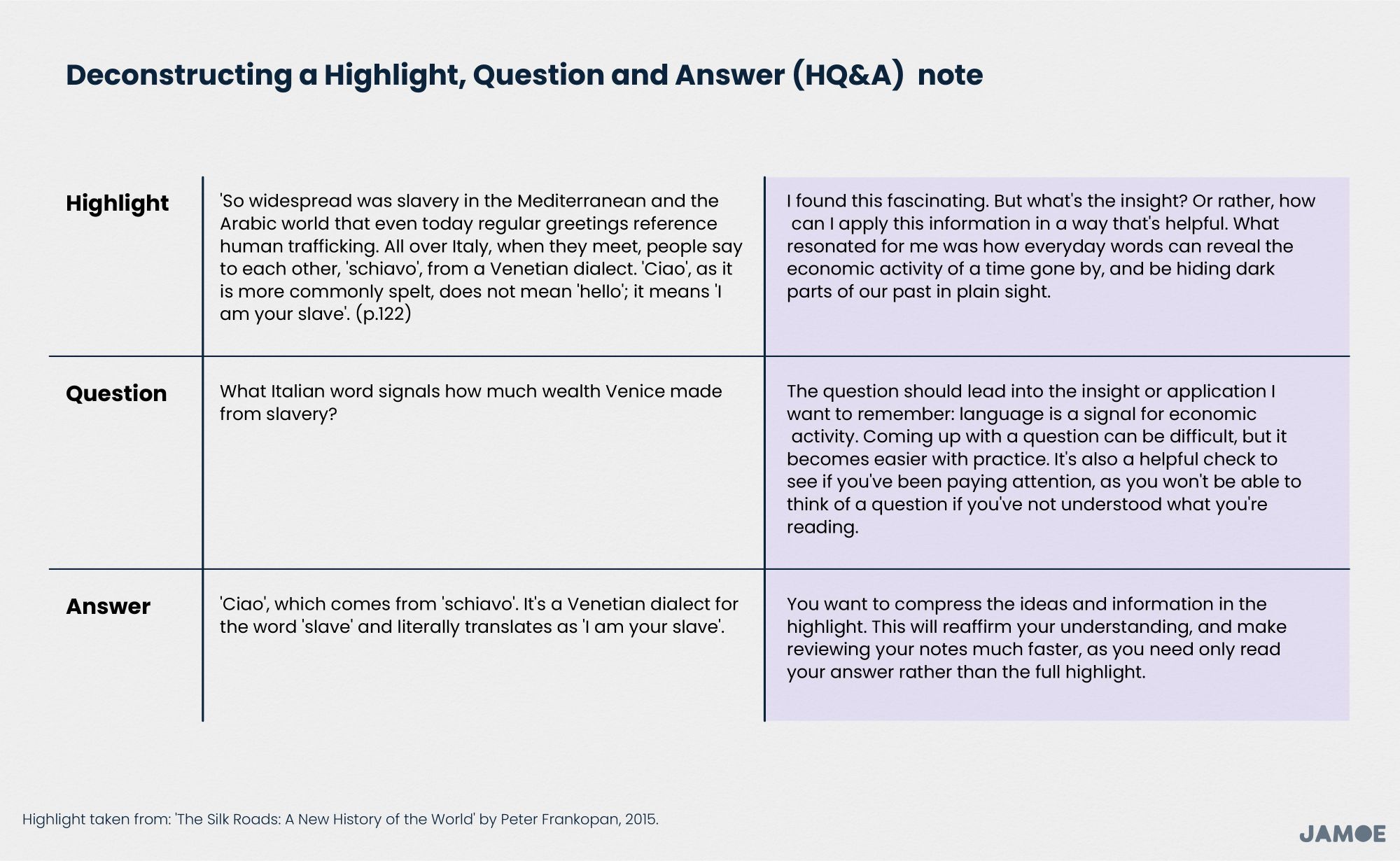
Foundations: How to review your HQ&A Notes
Don't read the highlight first:
- Read your question first: as you would a flashcard, quiz yourself. By reading the question first, you’ll re-enter the headspace you were in when you first wrote the note.
- Recall the answer: try to recall the answer, and then see how you did. This will reinforce your memory of the note per the active recall technique featured in our Spaced Repetition and Feynman Technique articles.
- (Optional) Read the highlight: if the question and answer didn't make sense or you want a reminder of the little details, you can re-read the highlight. With this approach, you can review your notes and jump between your compressed answer and the full context of the highlight.
A collection of inspirational examples
To make it more real, here are two more HQ&A Notes. They’ll give you a feel for how you can adapt your questions to strike at the heart of the insight(s) you want to remember.
The notes should be read Question, Answer, and Highlight, so they’ve been re-ordered to reflect how one would review the notes after having written them.
To see more real-world examples, you can view the notes we made while reading Bill Gates' 2021 book How to Avoid Climate Disaster here.
David and Goliath by Malcolm Gladwell
Question: What's shocking about class-size and academic achievement?
Answer: There is no statistically significant evidence to support the belief that small class-size results in stronger academic achievements. Follows an inverted U-curve. Too small = too little energy. Uninspired. Too big = too much energy. Unruly.
Highlight: 'After sorting through thousands of pages of data on student performance from eighteen separate countries, the economists concluded that... the evidence suggests the thing we are convinced is such a big advantage might not be such an advantage at all.' p.44
The Silk Roads: A New History of the World by Peter Frankopan
Question: How was product testing for animal fur done by the caliph in the 8th century?
Answer: 12 different animal furs were wrapped around water vessels and placed outside overnight. The one that didn't freeze was the warmest animal fur, and thus, the highest quality. The winner was black fox fur.
Highlight: ‘One caliph in the eighth century went so far as to conduct a series of experiments to freeze a range of different furs to see which offers the best protection in extreme conditions. He filled a series of containers with water and left them overnight in ice-cold weather according to one Arabic writer. “All were frozen except the one with black fox fur. He thus learned which fur was the warmest and the driest.”' p.107
Experiment: See if the technique will work for you
Start small. Find a piece of non-fiction and take a few HQ&A Notes.
When you start with the technique, it's normal to struggle to think of questions. That's because active reading is usually an unfamiliar mental muscle. With practice, applying the new ideas from the text and expressing them in your own words will become easier.
Questions don't need to be complicated, nor do they need to weave in every aspect of what you've highlighted. They just need to get to the heart of what you want to take away from the text.
That is, whatever you think will honestly be useful for achieving your goals.
The next day, review your notes. Quiz yourself using the questions you wrote, and see if you can recall the insights. Then reaffirm your understanding with the answers and highlights you made.
Advanced: Promoting original thinking by speculating with unanswered questions
After grasping the foundations of the HQ&A technique, you'll see that it's most useful for questions answered in the text, but what about unanswered questions?
These speculative questions are new ideas, connections or gaps in the text that you may want to follow up on to solidify your understanding of a new topic, as shown in the example below. The benefit of capturing them is that they'll serve as fertiliser for new essays, articles, investigations and Tweets.
Like all notes, we may never use them. That's fine. Storing ideas for the future is only part of the value of taking notes. The other part is digging intellectual rabbit holes that strengthen our thinking skills.
Practically, the process of taking an unanswered HQ&A note is the same: find the Highlight that inspired your Question; write your Question; write your educated guess as to what you think the answer might be.
When you come to review your unanswered HQ&A Notes, you'll have a reminder of what you were thinking at that moment and be able to use it as a springboard.
Of course, sometimes you’ll want to record a question but have no clue how to answer it. For these occasions, it's fine to leave it blank. You can always follow up later if the answer to that question becomes important for something you're working on.
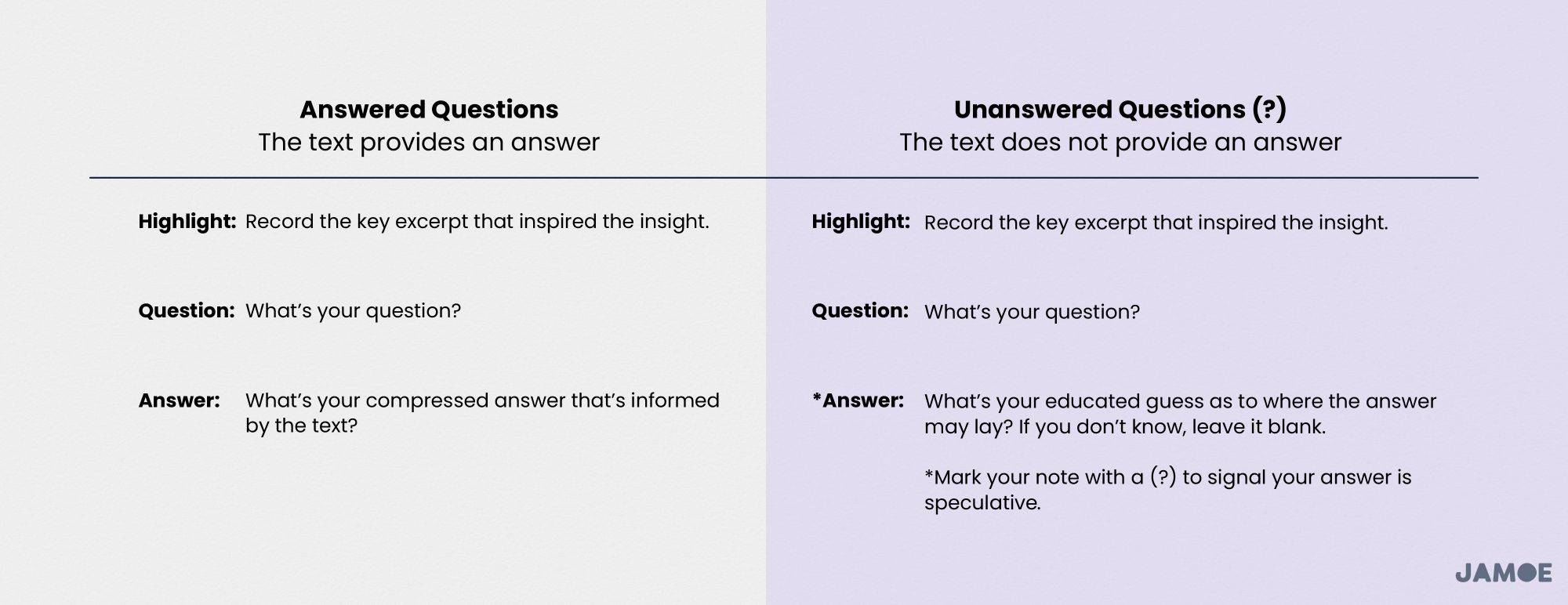
Unanswered question example
Below is a Speculative HQ&A note we took while reading Moneyland: Why Thieves And Crooks Now Rule The World And How To Take It Back by Oliver Bullough.
For context, ‘Moneyland’ is the name given to the nebulous location that houses illegal money. That is, money that’s been off-shored for tax evasion or to hide stolen funds:
Question: Would Bitcoin increase or decrease money laundering via Moneyland, that is, money earned through corruption and crime?
Answer: Bitcoin is a means of transferring value, so I presume it cannot, by itself combat money laundering. The blockchain, with better indexing tools, however, may make it easier to track the flow and source of funds in the future. (?)
Highlight: 'Moneyland exists because it makes money for its stewards, who are well paid for serving its wealthy citizens. They, not the Moneylanders, are the tigers whose claws and teeth are shell companies, trusts and secret bank account.' p.74
The question mark (?) is how we recommend identifying speculative questions that need further investigation and development before they can be considered fully formed.
The benefit of doing this is that it helps us think faster in the future. Imagine that we end up needing to write a piece on the connection between money laundering and cryptocurrencies. We might stumble across the above unanswered HQ&A note. Giving us a starting point can use it as a springboard to make the research and writing process faster. That's all part of achieving more with less by using yesterday's momentum.
Conclusion
We've covered the most basic form of the Highlight, Question and Answer (HQ&A) note-taking technique. However, view it as a serving suggestion. As long as you keep the principles in place, you can customise it to your needs.
For example, as you become more comfortable, you can start thinking about taking HQ&A Notes at different levels of abstraction. At first, you'll take a HQ&A note to summarise paragraphs. As your active reading skills develop, you might then venture into using the HQ&A technique to summarise multiple pages, a chapter, or an entire book.
For these higher level HQ&A Notes, you'll want to use the Highlight that best captures the crux of the insight you want to store it for later. Once you've found it, think of a poignant question that will prompt you to recall that insight.
For more depth on HQ&A Notes, like how to practically apply them with and without a computer, please see the other articles in our Honest Notes note-taking series.
Read part two in our note-taking series.
